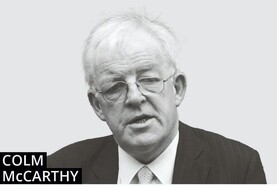Up to the 1980s, there were four commercial airports on the island of Ireland, three belonging to the Republic’s State-owned Aer Rianta and one near Belfast in Northern Ireland.
The three airports in the Republic were Dublin, by far the largest then and now, around 10 kilometres to the north of the city centre; Cork on the south side of the island’s third largest city; and Shannon, near Limerick.
Aldergrove was Northern Ireland’s only airport, nowadays called Belfast International, a fair distance, about 25 kilometres, to the west of the city close to Lough Neagh.
Plans were being hatched elsewhere for further airports, accompanied by claims that they would help to stimulate regional development.
Significant traffic
Just one of these succeeded in attracting significant traffic, the reopening of Belfast City airport which did not require runway construction, using the pre-existing facilities of the Short Brothers aircraft plant in the city centre.
Seven ‘regional’ airports were opened in new locations distant from population centres, one in Northern Ireland at Eglington near Derry and no fewer than six in the Republic.
All were in receipt of public funds for capital works as well as operating subsidies to airlines.
Three of the six in the Republic no longer offer scheduled service. Galway and Sligo have closed, Waterford remains nominally open but the last scheduled service was withdrawn in 2016.
Politicians and regional lobby groups have been arguing that the passenger cap imposed at Dublin presents an opportunity to divert traffic to the regions, noting that all, including Cork and Shannon, have ample capacity.
Explicitly
So does Dublin of course, since the new east-west runway was planned decades ago explicitly to cater for traffic expansion.
One of the reasons for the popularity of Dublin airport is the improvement to surface connections from the regions, especially the motorway network now almost complete, which has facilitated shorter trips from around the island, including Northern Ireland, and frequent scheduled bus routes for passengers.
Dublin airport is now the busiest bus station in the country.
The expansion of smaller airports in the regions coincided with the modernisation of the road network which has taken away their attractions for users.
In 2023 passenger volumes at Cork, even more so at Shannon, remained significantly below pre-COVID levels.
At the three regional airports in the Republic offering scheduled service, Kerry, Knock and Carrickfinn in Donegal, combined annual passenger numbers are not much ahead of the peak weekly figure at Dublin.
Welcomed
A cap on permitted numbers at Dublin would be welcomed by management at Cork and Shannon, both of which have insufficient volumes in what is largely a fixed-cost business.
Operating losses at Cork are buried in the aggregate accounts of the DAA, which owns Cork as well as profitable Dublin, while Shannon’s losses are also unknown, hidden in the accounts of the so-called Shannon Group which includes the legacy rent-roll of Shannon Free Airport Development Company.
There are reasons for advising management at Cork and Shannon against premature celebrations.
The cap may never be imposed since the matter is headed for the High Court.
Crucially the prospects for traffic to divert are not promising even if the cap is retained.
The closest airports on the island are not in the Republic, they are in Belfast, whose hinterland produces around 10% of total passengers at Dublin.
The figures for Northern Ireland are roughly six million users for Aldergrove, three million for Dublin and around two million for Belfast City.
Passes
Belfast really has three airports, with Dublin in second place after Aldergrove. The M1 (Belfast) motorway passes the front gate of Dublin Airport and journey time from Belfast’s southern suburbs is not much more than an hour.
There are round-the-clock bus services.
Belfast International has 11 flights a week to Paris, four a week to Amsterdam and none to any other European hub (none to Heathrow for example), and has become a holiday airport in which easyJet and Ryanair are the main operators.
Belfast City does a little better with seven dailies with British Airways to Heathrow.
Dublin has around 50 departures per day to the main hubs at Amsterdam, Frankfurt, Heathrow and Paris Charles de Gaulle as well as direct service to all principal business and holiday destinations in Europe, north America and the Middle East.
The first airline reaction to the passenger cap came from Ryanair, which has announced new routes away from Dublin, but unsurprisingly just up the road at Belfast.
No new routes for Carrickfinn, or Knock or Kerry, and none for Cork or Shannon either.
If the cap survives, there will indeed be a boost for airports and regional development away from Dublin, but not where the political cheerleaders expect.
Economic geography trumps political lobbying and the winner will be Belfast.






 This is a subscriber-only article
This is a subscriber-only article










SHARING OPTIONS: